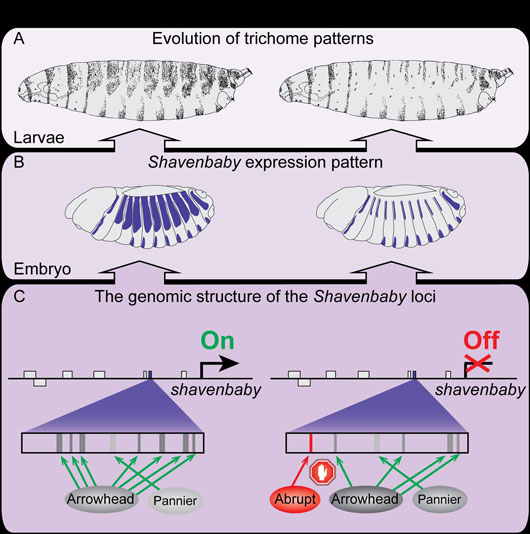Development is extremely robust to genetic and environmental instabilities. Transcriptional robustness, for example, can result from the redundant activities of multiple enhancers for the same developmental gene or from the robust function of single enhancers that contain clusters of binding sites for the same transcription factor. Robustness clearly evolved to facilitate life on a variable earth. But robustness also presents an evolutionary paradox: how can robust transcriptional systems evolve altered functions through mutations of small effect to drive morphological evolution?
Solving this problem requires comprehensive studies of individual enhancers that have evolved to generate phenotypic diversity. In a recent paper in Developmental Cell, we report the discovery of the regulatory changes at an enhancer for the Drosophila shavenbaby gene that have contributed to morphological evolution. Shavenbaby encodes a transcription factor that controls the development of cuticular hair-like projections called trichomes. Trichome patterns have repeatedly evolved in larvae of the genus Drosophila via changes in the shavenbaby regulatory region. Seven enhancers in the cis-regulatory region upstream of the shavenbaby promoter control the complex embryonic expression of shavenbaby in D. melanogaster and their overlapping functions provide robustness of shavenbaby expression against genetic and environmental variations. In D. sechellia, a sister species to D. melanogaster, multiple nucleotide changes in five of these enhancers have led to reduced enhancer function that resulted in loss of shavenbaby embryonic expression and the evolution of naked larval cuticle.

Figure: Trichome patterns have evolved between Drosophila species by changes in the regulatory region of the shavenbaby gene. (A) Lateral view drawings of first instar larvae of D. melanogaster (left) and its closely related species D. sechellia (right). (B) Drawings of shavenbaby embryonic expression patterns. (C) Schematic representation of the shavenbaby locus (top), indicating embryonic enhancers (light gray boxes). The evolved E6 enhancer is highlighted in purple. A model summarizing the state of transcription factor occupancy at the E6 enhancer is shown below. The D. melanogaster E6 encodes multiple binding sites for the transcriptional activators Arrowhead and Pannier that direct shavenbaby expression in quaternary cells, resulting in trichome formation. Four of the Arrowhead binding sites were lost in the evolutionary lineage leading to D. sechellia, resulting in a partial loss of E6 function. The acquisition of a binding site for the strong repressor Abrupt caused complete suppression of E6 activity, leading to the loss of shavenbaby expression and the transformation of trichomes to naked cuticle in D. sechellia.
Using a combination of genomic, genetic, biochemical and functional studies, we deciphered most of the regulatory changes in one of these enhancers. We discovered that the D. melanogaster enhancer encodes multiple binding sites for the transcriptional activator Arrowhead that are required for robust expression of shavenbaby. Four of these Arrowhead sites were lost in the evolutionary lineage leading to D. sechellia. Despite the loss of Arrowhead sites, the D. sechellia enhancer maintained functional activator sites that can drive expression. However, the D. sechellia enhancer also acquired a binding site for the potent repressive transcription factor Abrupt. Upon binding, Abrupt overcomes the residual expression driven by the remaining activator binding sites, leading to a complete suppression of embryonic expression. These results provide an understanding, at unprecedented resolution and comprehensiveness, of how one enhancer has evolved altered function to contribute to morphological evolution. In addition, these findings illustrate that robustness encoded by multiple binding sites can be overcome by binding of a strong repressor and suggest that recruitment of repression may be a general mode of evolution to break robust regulatory linkages.
Reference
Evolved repression overcomes enhancer robustness. Preger-Ben Noon E., Davis FP. and Stern DL. Developmental Cell. 2016 Dec 5; 39(5):572-584. DOI: http://dx.doi.org/10.1016/j.devcel.2016.10.010.


































